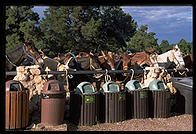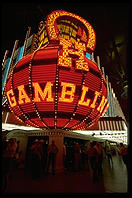
Canon EOS-3
by Philip Greenspun; created 1999
Site Home : Photography : Canon EOS-3
 I own about a dozen Canon EOS lenses so I'm always at least a little bit
interested in what body to stick behind them. I never really liked
the EOS-1n so I mostly settled on a couple of
EOS-5
bodies. Now [October 1998] Canon has announced the EOS-3 body. This article
is my attempt to analyze the new product based only on Canon advertising
literature (i.e., I've never held an EOS-3 body in my hands).
I own about a dozen Canon EOS lenses so I'm always at least a little bit
interested in what body to stick behind them. I never really liked
the EOS-1n so I mostly settled on a couple of
EOS-5
bodies. Now [October 1998] Canon has announced the EOS-3 body. This article
is my attempt to analyze the new product based only on Canon advertising
literature (i.e., I've never held an EOS-3 body in my hands).
It is always more fun and interesting to complain than to praise. My first complaint is that the new body does not keep track of exposure information, so you'll be saying "uh, f/8 and something, I think" a lot. There are all kinds of great cameras out there that use their microprocessors to imprint these data between frames (the now-ancient Nikon F4 could do this), hold these data for later download (the rather old Nikon N90 does this), or, slickest of all, skip the first two frames on a roll and then imprint these data on them after rewinding (Contax AX).
My second complaint is that Canon did not license the Nikon D system for fill-flash. The EOS-3 has some slick flash stuff that is useful if you're willing to buy lots of new flashes, but to work accurately the Canon flash system still depends on having a subject that is 18% gray (or a photographer vigilant and lucky enough to dial in the correct flash exposure compensation).
My third complaint is that there is no built-in flash. These are nice to have in emergencies! (Given that the EOS-3 is water-sealed (see below), it probably would have been tough to do this.)
My final complaint is that the camera promises to be heavy. You might need the power booster E3 to get convenient vertical handling. In this case, weight is 1215 grams (just shy of the weight of the EOS-1 + power booster and nearly double the weight of a 675 gram EOS-5). The EOS-3 body alone is 780 grams.
For this reason alone, I will buy a couple of EOS-3s. On the EOS-5, you have to choose between using the thumb button on the back for AF or depth-of-field preview. The EOS-3 has a dedicated DOF preview button right next to the lens mount where it belongs.
The EOS-5 is unique in the camera world in that there is no external flash that gives you an AF-assist light. The on-camera AF assist light doesn't work for serious photographers because the Canon L lenses are all too bulky and obstruct the light. With an EOS-3 you can just buy the 550EX flash and you've got a powerful AF assist light.
Canon claims that the EOS-3 is as well-sealed as the EOS-1. This would make it capable of operation in fairly heavy rain. The EOS-1 used to be the only camera in the world that could do this. I think the Nikon F5 has this kind of sealing as well so the EOS-3 would be the third camera on the market that can be used with confidence in the sort of weather that yields great photos. It will also be the cheapest and lightest sealed SLR.
Canon now offers wireless TTL control of off-camera flashes either from an on-camera flash or an on-camera IR transmitter. In this they've caught up to where Minolta was in the 1980s. Wahoo!! Anyway, it is a useful feature. Note that users of older Canon bodies can achieve most of the benefits of the new system by purchasing a Wein wireless base for their Canon flashes.
From the brochure it looks like you can see both an ambient exposure scale and a flash exposure scale in the viewfinder. Thus you can visually see the fill ratio when combining flash and ambient light.
The finder display also has a count-up or count-down frame counter.
The new AF system has lots more sensors (45) and allegedly lots better eye control. I was never able to get eye control to function usefully on my EOS-5 bodies so I'm not planning to rely on this feature. The central sensor works with lenses as slow as f/8 so someone with a 300/4 plus 2X teleconverter might be able to easily capture birds in flight (most SLR bodies can only do AF with lenses that are f/5.6 or faster).
Note that many of the most precise sensors only work with f/2.8 and faster lenses (and then another important AF sensor requires an f/4 lens). So don't think that the EOS-3 will make you a hero if you've got a slow consumer zoom lens!
If you get the PB-E2 power booster, you get the same control layout in horizontal and vertical orientation (since the booster/grip duplicates the most important camera controls). I'm not sure if you get this with the lighter/simpler BP-E1 battery pack/grip.
I put this in because so many people send me email asking for comparisons between bodies made by different companies. If you've got a big Nikon lens system, the EOS-3 is of little utility. If you've got a big EOS lens system, the F5's color-based metering system won't seem all that advanced.
And new photographers? Should they choose a system based on the features of the body du jour? Clearly not. For there will be an F6 and a N100 and an EOS-4.
Anyway, since I know I'll be asked, I'll say it now: I think the EOS-3 body, which I've never seen, is probably a slightly more effective machine than the Nikon N90, which I've used only once.
Here's the in-camera motor drive at work:
Here are some pictures from the two EOS-3 bodies that I picked up in August 1999 before going rafting through the Grand Canyon:
some difficult metering ...
a little autofocus action ...
Want to see more? Check my review of the 50/1.4 lens, which is illustated with EOS-3 output.
Now that I've put about 25 rolls of film through two EOS-3 bodies, I can say a little bit about the camera. It is noticeably heavier and noisier than the EOS-5. The autofocus seems to work a bit better. I haven't given the eye control feature a fair try but it isn't obvious that it works consistently. Using mirror lock-up with the self-timer for tripod photos is painful compared to the EOS-5. With the EOS-5, you simply push the self-timer button and touch the shutter release, leaving the "mirror-prefire when self-timer engaged" custom function on all the time. The EOS-3 provides real mirror lock-up. So to make a landscape image on a tripod, you have to
Then repeat these steps to go back to regular picture taking.
I subjected both bodies to a fair amount of sand and water during my seven days on the Colorado River. One of the top deck buttons on one of the bodies became sticky. Otherwise the cameras and power booster have performed flawlessly. Metering seems to be accurate.
Probably the best body for EOS users. The sad thing is that you'll need that power booster for vertical handling. Fill it up with 8 lithium AAs (instead of alkaline) and it won't make quite as big a dent in your neck. You'll also be able to burn 120 rolls of film before changing batteries!
Text and pictures (c) Copyright 1999 Philip Greenspun